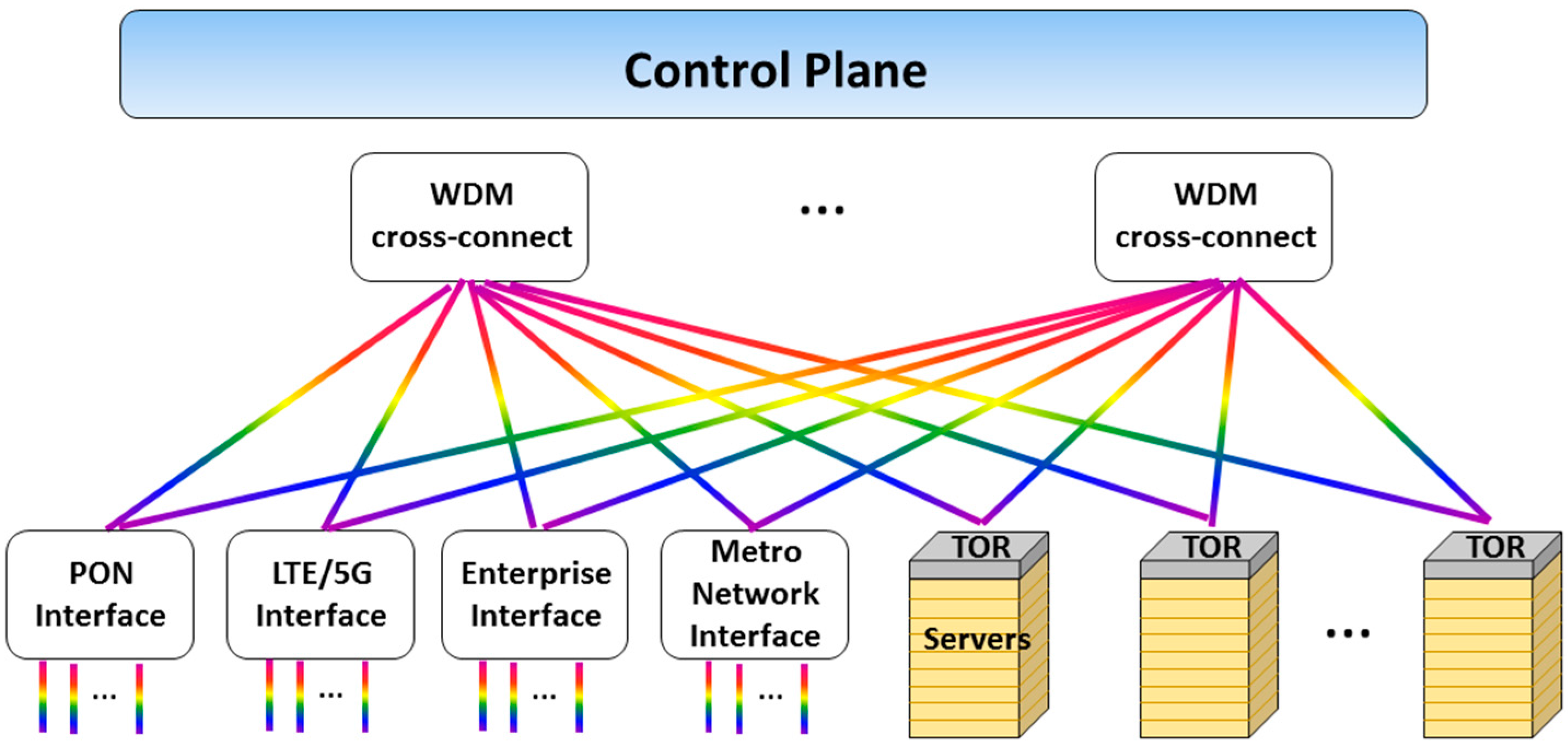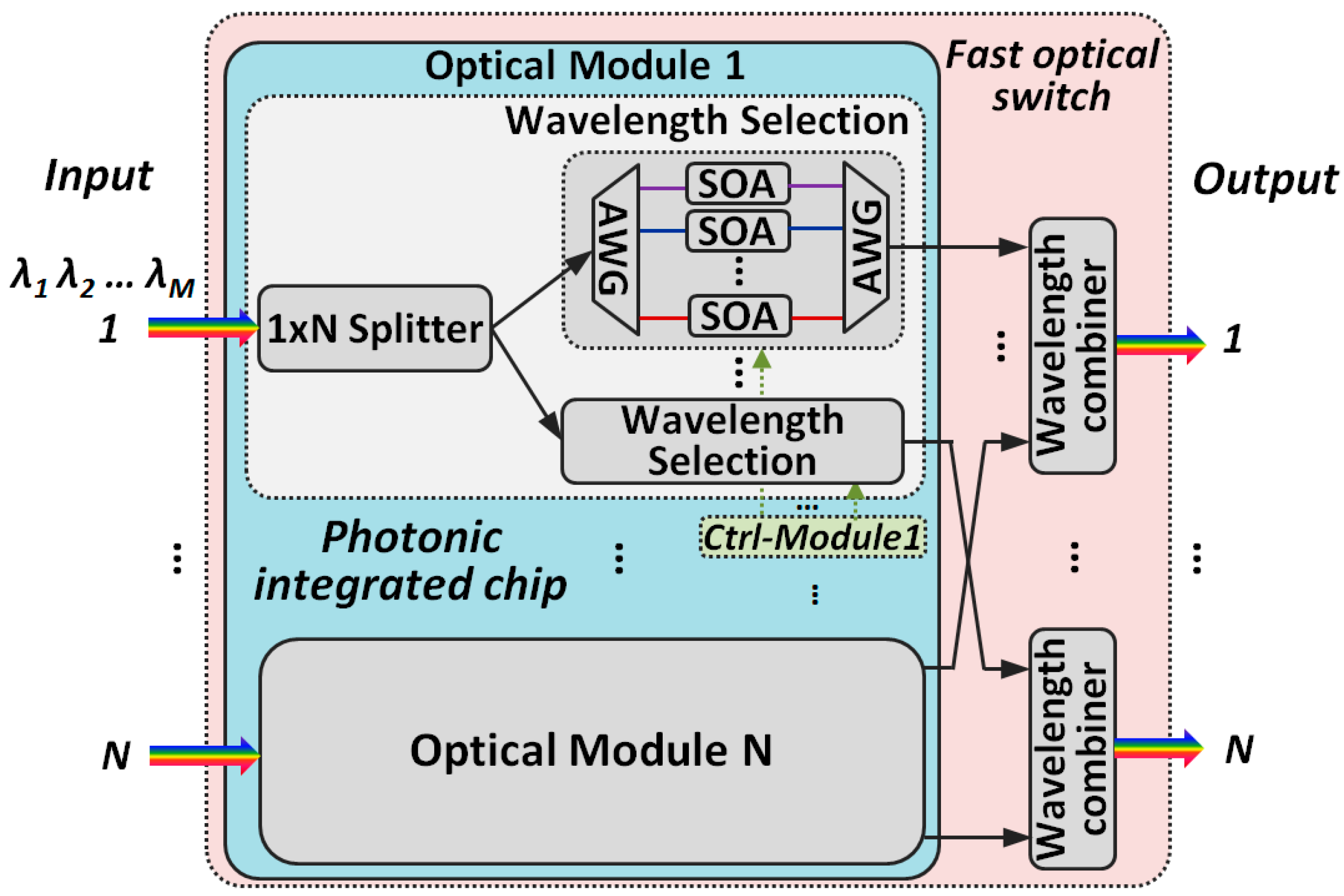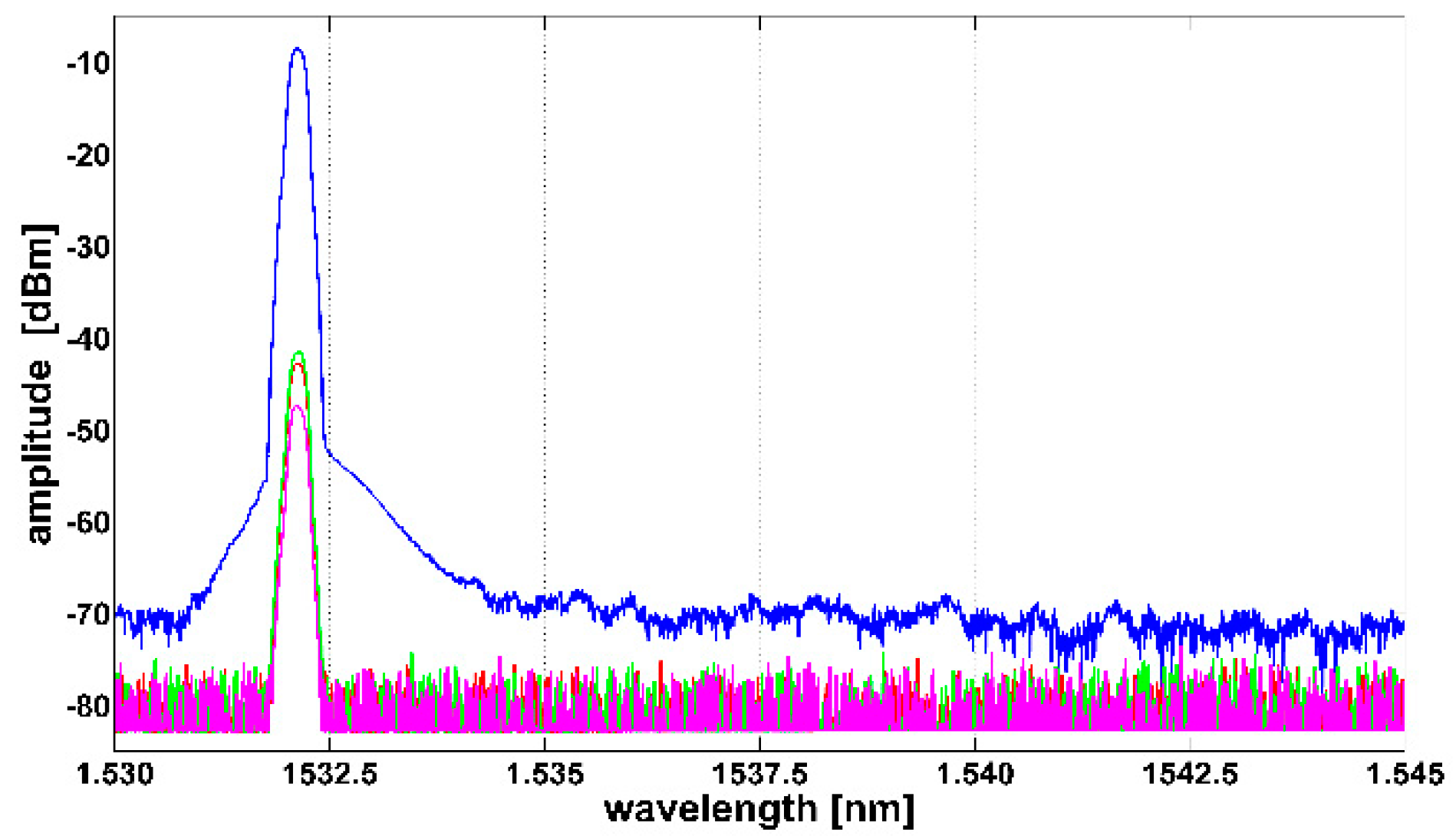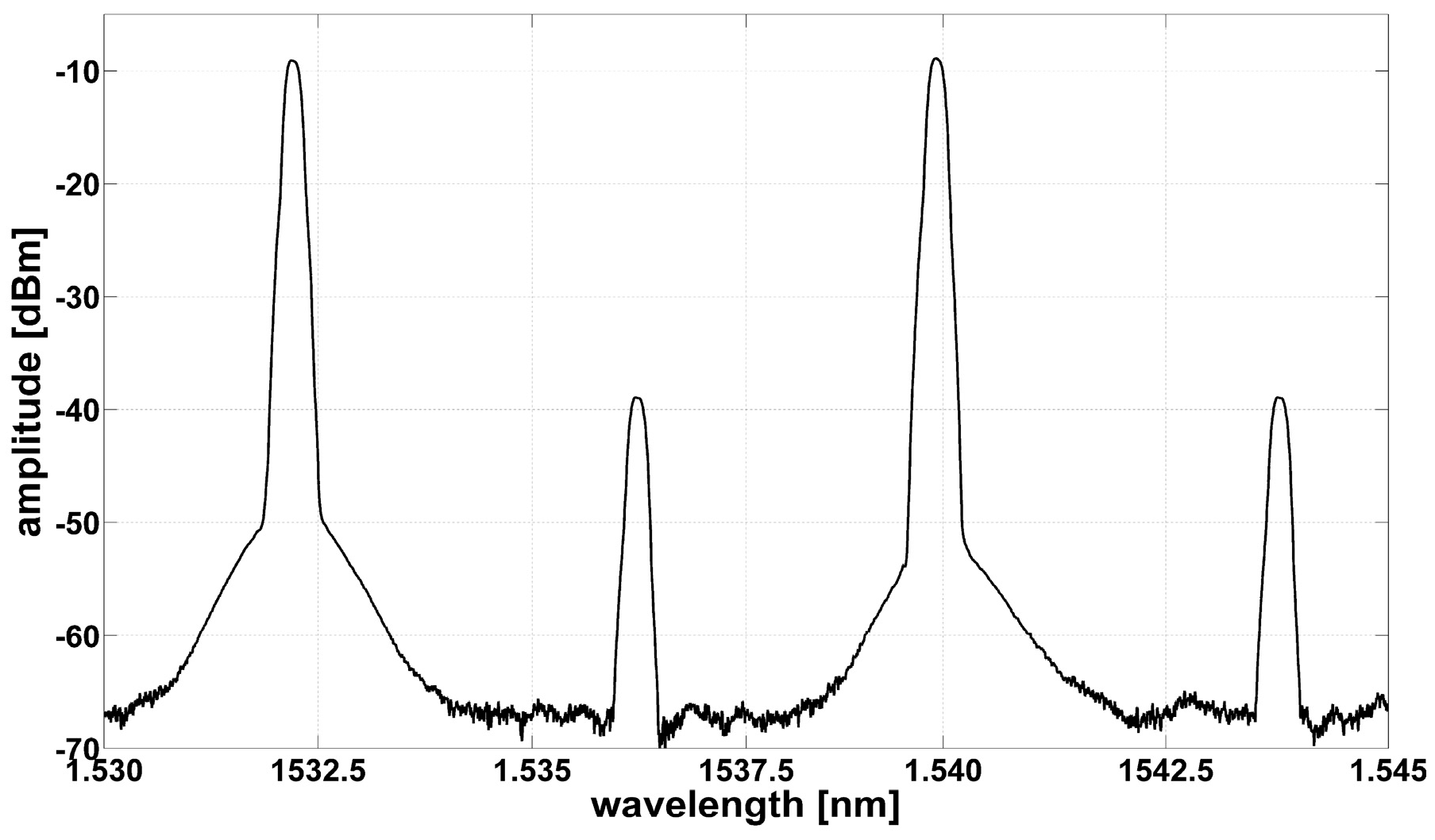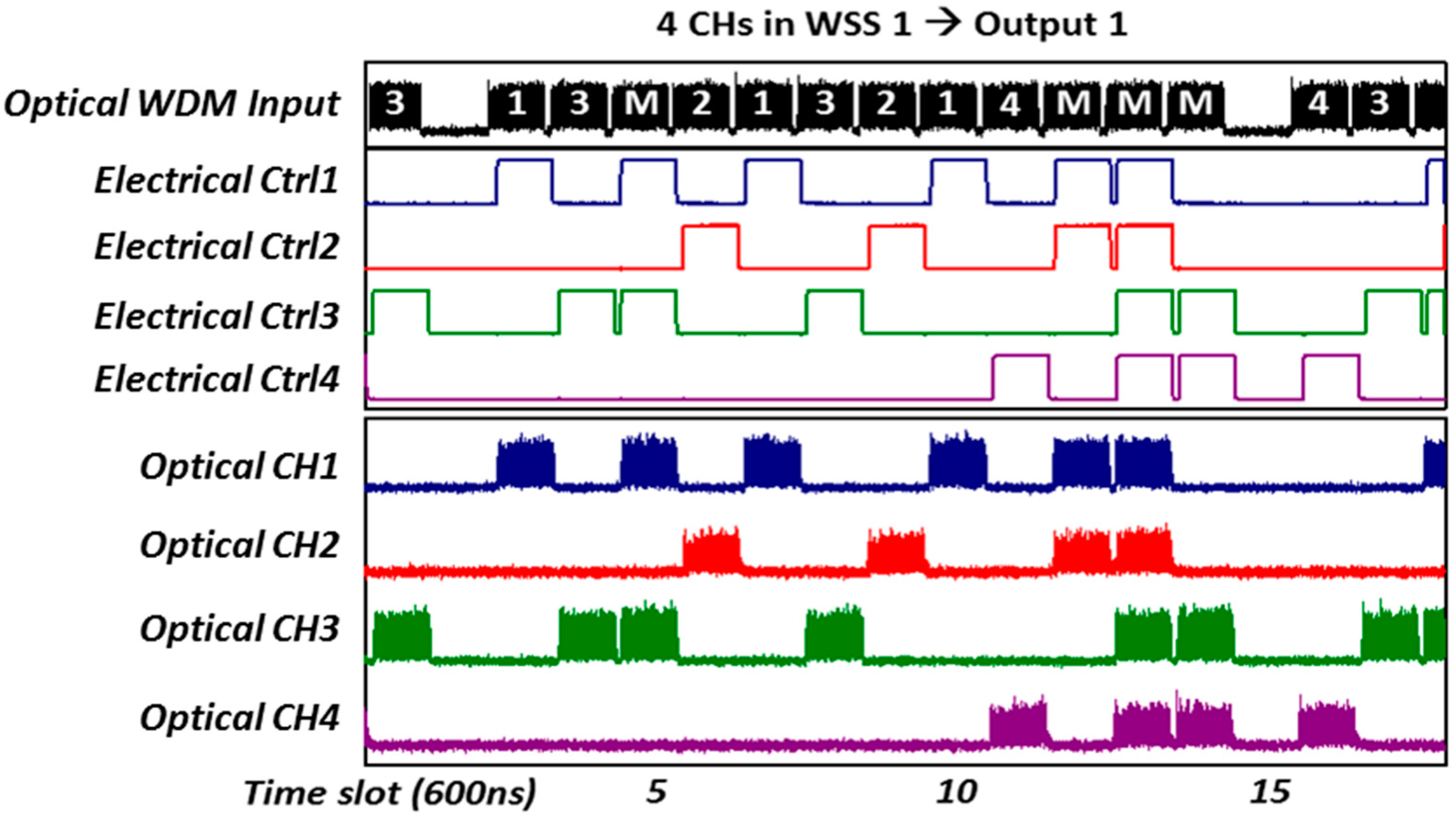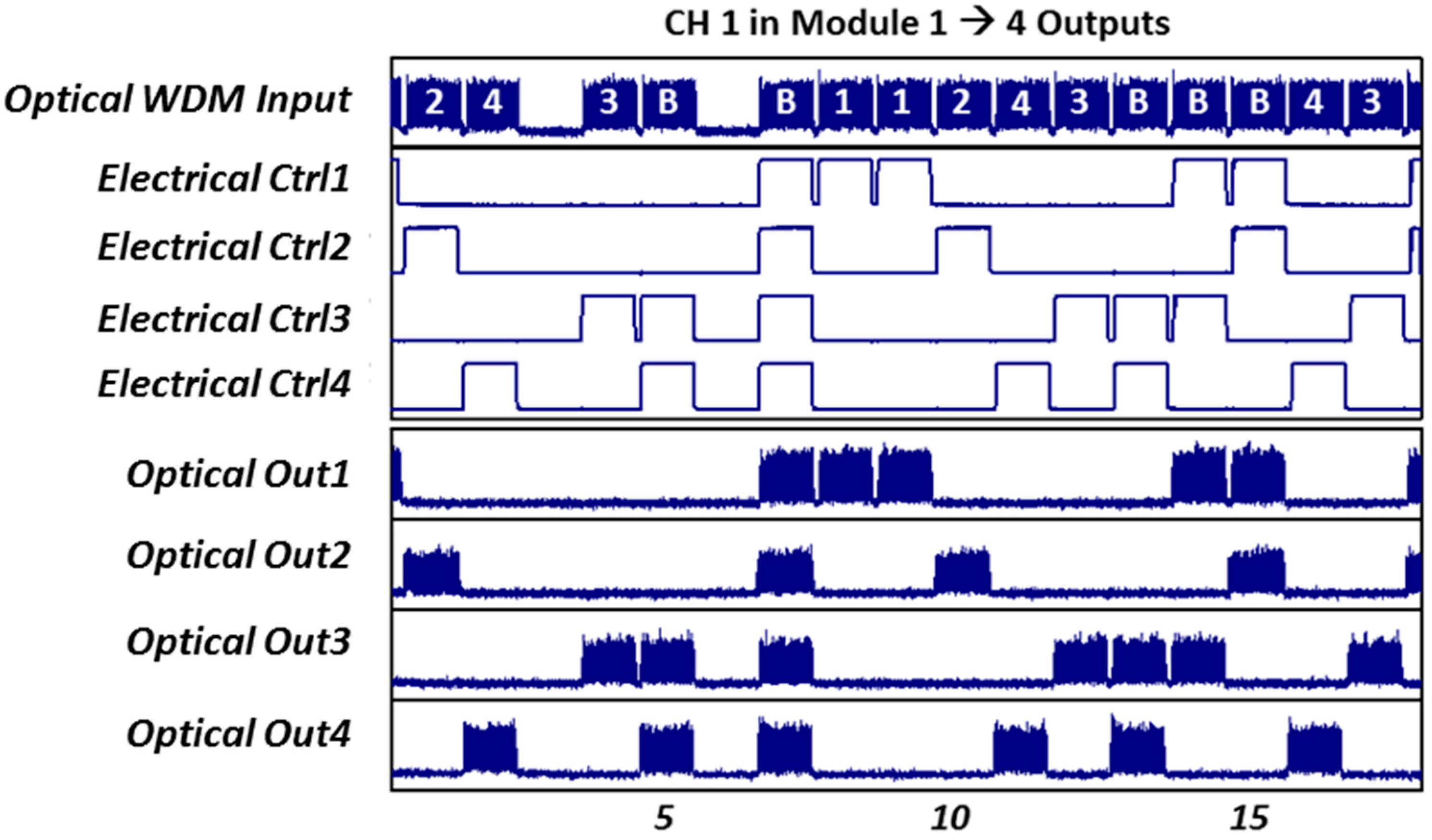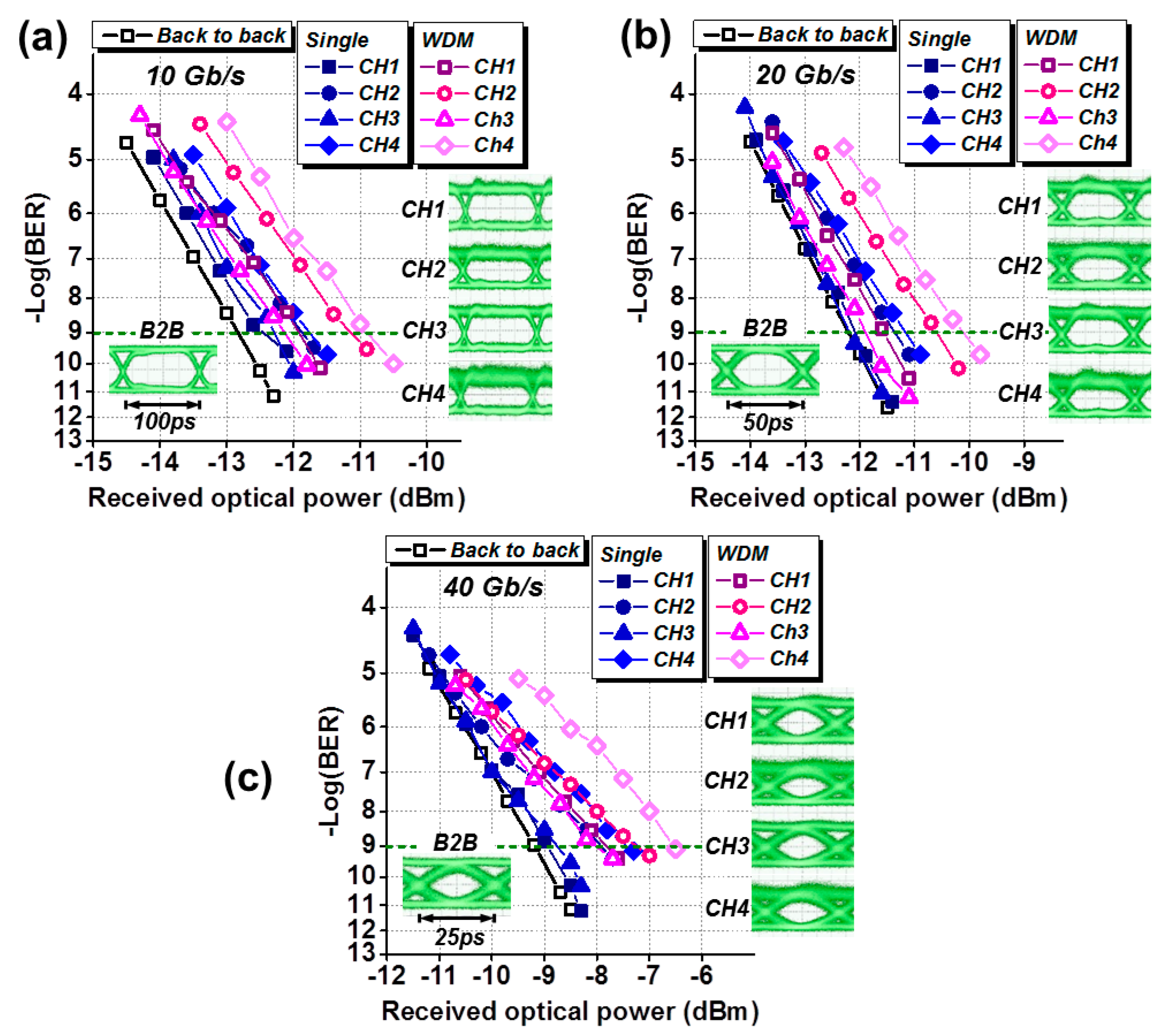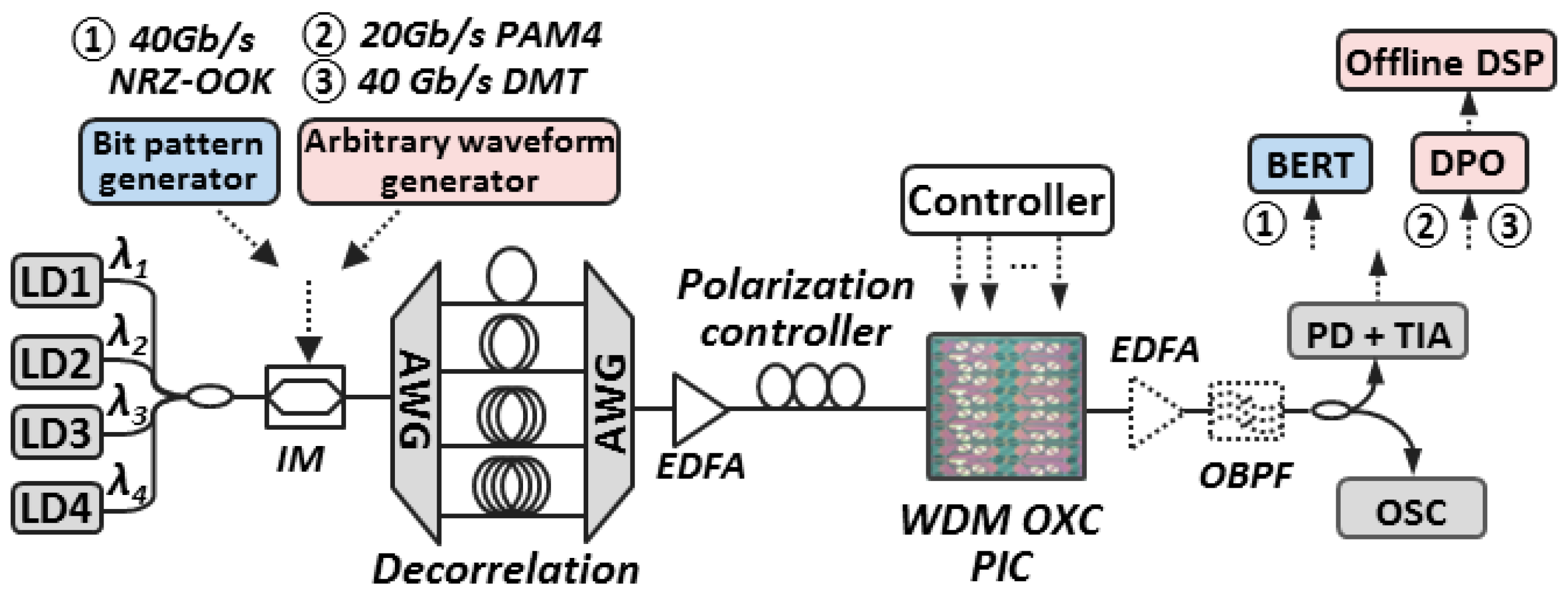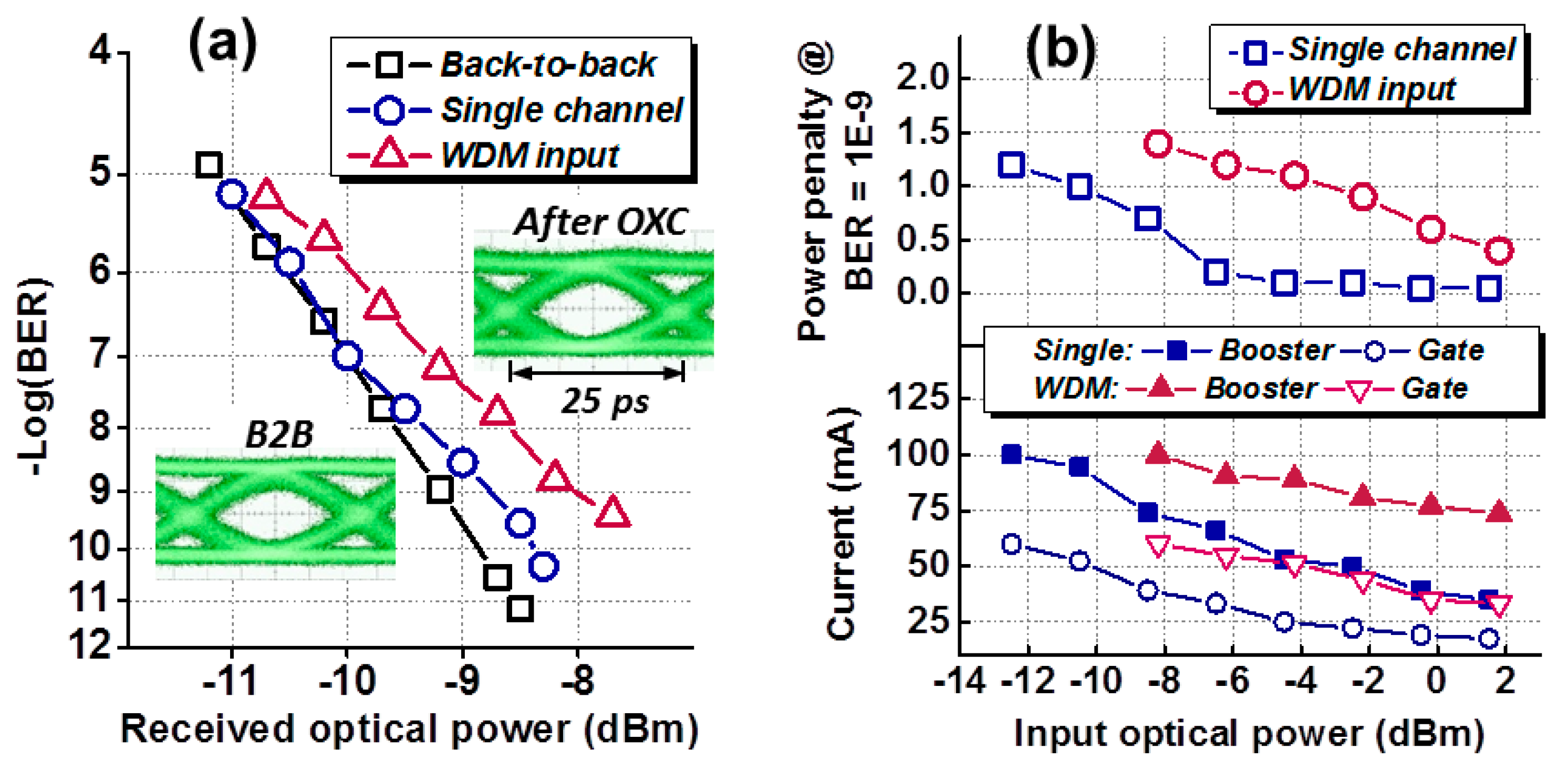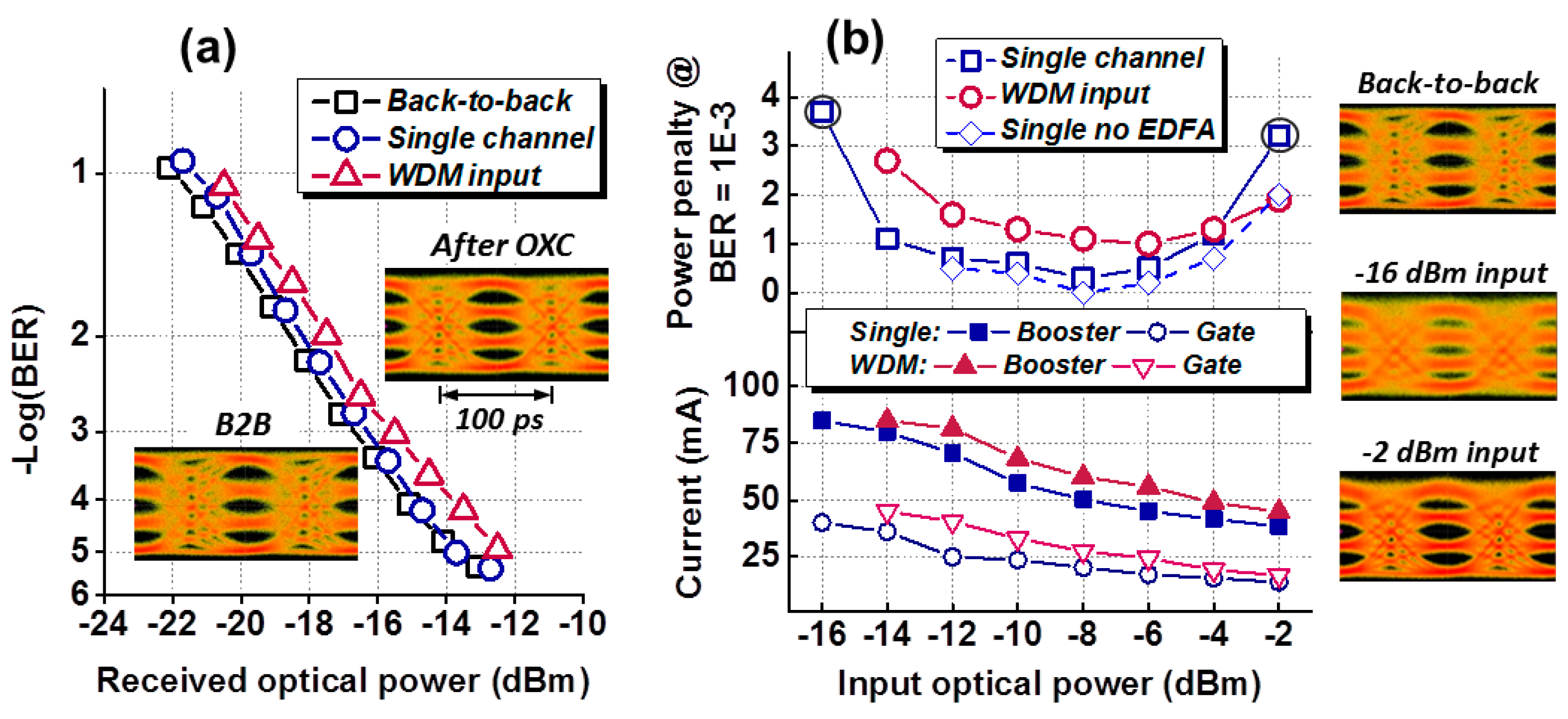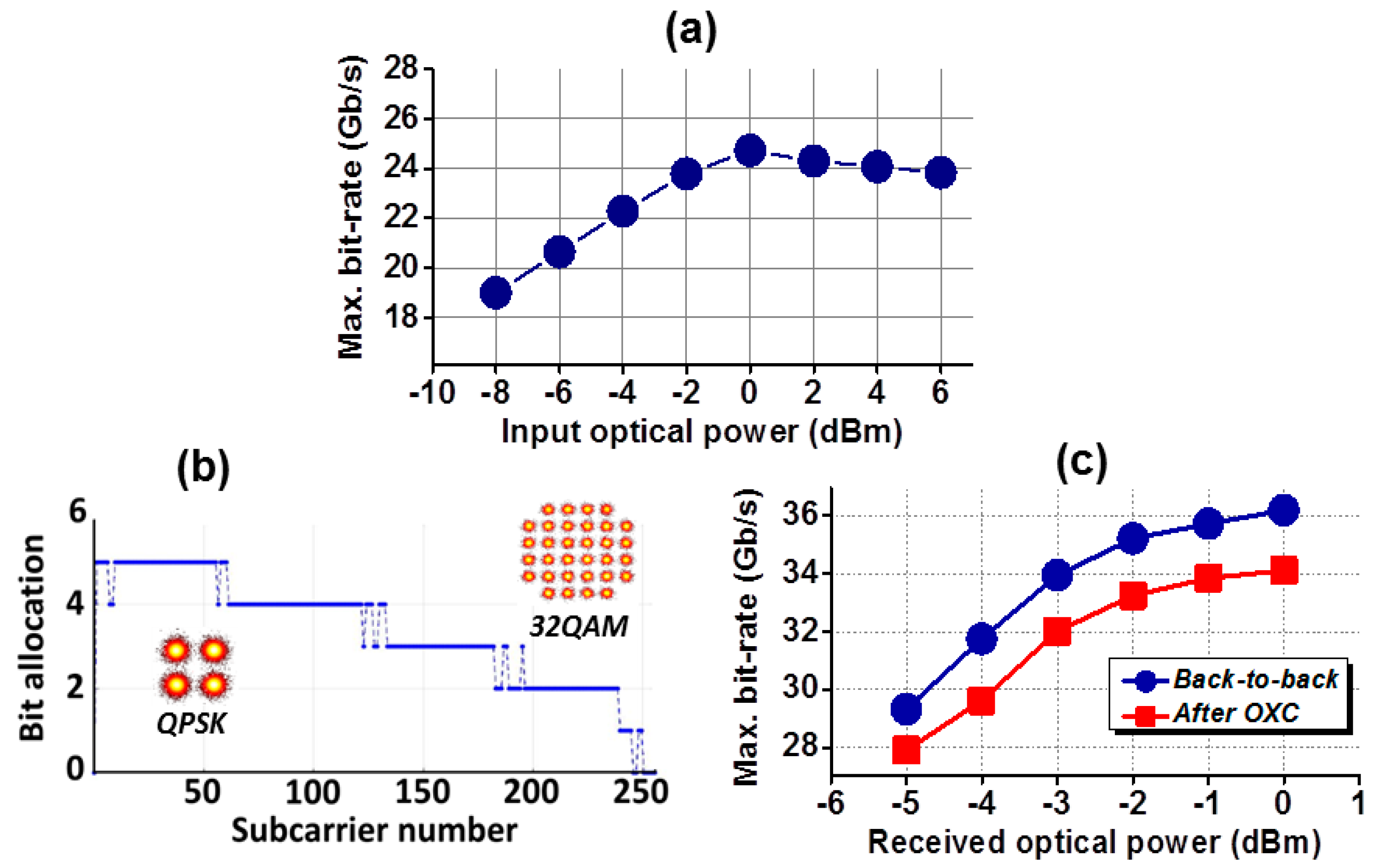1. Introduction
Optical metro networks face significant challenges supporting ever-increasing bandwidth demands and ever increasing service expectations [
1]. High-performance next-generation dynamic optical metro networks should efficiently support a variety of access applications with dynamic traffic patterns (LTE and 5G backhaul and fronthaul, multi-technology Passive Optical Networks (PON), data center interconnects, enterprises, etc.) as well as multi-Tbit/s interfaces with core networks by leveraging the latest advances in optical transmission and switching. Moreover, applications, such as 5G with deployment of multiple antennas and MIMO radio configurations, require not only large bandwidth beyond 100 Gb/s, but also the computing and storage resources for processing the signals from the radio antennas. Therefore, next generation metropolitan nodes will co-allocate telecom network elements and compute and storage resources to cope with such applications. In addition, new developments in network virtualization could partition the optical data layer to be able to accommodate a wide range of use cases, from the vertical industries and other infrastructure users with different requirements (e.g., latency, resiliency, and bandwidth) allocating logical networks and infrastructures, optimally tailored for each specific use case. This requires the metro node network architecture to be a flexible infrastructure that can be adapted and scaled on demand according to the applications. On the other hand, power consumption and costs of such infrastructures should be sustainable as the infrastructure scales with data rate and network elements, as well as computing and storage resources.
Several programmable optical metro node architectures based on simplified, flexible, and cost-efficient optical switching and transmission technology, with high capacity and faster network reconfiguration and with efficient exploitation of the available optical spectrum, have been currently investigated [
2,
3,
4,
5,
6]. Novel node architectures based on the “whitebox” concept, including “distributed DC” capabilities, i.e., using disaggregated hardware in a vendor-neutral approach and having local processing and storage resources, is highly promising for integrating commodity hardware with telecom network elements. In the target architecture of Central Office Re-architected as a Datacenter (CORD) [
3] shown in
Figure 1, it includes a collection of commodity servers interconnected by a fabric constructed from electrical whitebox switches. The switching fabric is organized in a leaf and spine topology to optimize for traffic flowing east to west between the access network that connects customers to the Central Office and the upstream links that connect the Central Office to the operator’s core network.
Relying on the implementation of a high-bandwidth electronic switch node is limited by the switch ASIC I/O bandwidth due to the scaling issues of the ball grid array (BGA) package [
7]. Higher bandwidth is achievable by stacking several ASICs in a multi-tier structure, but at the expense of larger latency, higher cost, and power consumption. Moreover, power consumption is an additional issue for such switches. In addition to the power-hungry electronic switching fabrics, the E/O and O/E conversions at the switching node actually dissipate a large portion of the consumed power [
8].
Switching the data signals in the optical domain has the potential to overcome the scaling issues of electronic switches [
9]. The advantages of deploying optical switching technologies in an optical metro node are multi-fold:
Transparency to data-rate and data-format allows for extremely high I/O bandwidth without implementing signal-dependent interfaces.
- (1)
The high capacity helps to flatten the network topology, avoiding bandwidth bottleneck and large latency caused by hierarchical structures.
- (2)
Massive O/E/O conversions can be eliminated, improving the energy-efficiency and cost-efficiency.
- (3)
The reduced number of cables benefitting from the high port capacity may facilitate the deployment and management of the network.
Several optical switching schemes have been proposed and investigated [
10,
11]. Optical switches based only on space have inefficient bandwidth utilization and inflexible connection. On the other hand, only time domain fast optical switches can offer sub-wavelength granularity for on-demand and high-degree connectivity by exploiting statistical multiplexing. To fully reap the profits from the statistical multiplexing, the switch should support fast scheduling and reconfiguration at the nanosecond scale. Nevertheless, the optical switch featuring with nanoseconds reconfiguration time has been only demonstrated with limited port-count [
12,
13,
14]. An innovative optical interconnect network architecture for data center network architecture based on fast flow-controlled optical cross-connect (OXC) switches have been employed as the distributed switching elements in [
15]. The capability of switching the aggregated traffic in both time and wavelength domain at the nanosecond scale has further improved the flexibility and feasibility of the system. However, no application to optical metro network node architecture has been reported, and experimental assessment of the WDM optical cross-connect switch has been performed only for non-return to zero signals and for a limited optical power dynamic range.
In this work we present a novel optical metro node architecture that exploits the WDM optical cross-connect nodes for interconnecting network elements, as well as computing and storage resources. The experimental assessment of a photonic WDM cross-connect node based on semiconductor optical amplifiers (SOA) as a main building functionality for implementing the interconnected network of the metro node is also reported. The advantages of using an SOA to realize the WDM cross-connect switch in terms of switching speed, photonic integrated amplification for loss-less operation, and gain equalization will be verified experimentally. Experimental results on the assessment of a 4 × 4 photonic integrated WDM cross-connect confirmed the capability of the cross-connect chip to switch WDM signal in space and wavelength. Experimental results show lossless operation and cross-talk <−30 dB. Compensation of the losses is a good indication that the modular architecture could scale to a larger number of ports. Moreover, the operation of the cross-connect switch with multiple WDM channels and diverse modulation formats is also investigated. Experimental results confirmed the capability of the cross-connect chip to dynamically switch, within a few nanoseconds, the WDM data packets in space and wavelength. Error-free operation with less than a 2 dB power penalty for a single channel, as well as WDM input operation, has been measured for multiple 40 Gb/s NRZ-OOK, 20 Gb/s PAM4, and data-rate adaptive DMT traffic.
The paper is organized as follow. In
Section 2, a brief description of the optical metro node architecture comprising of the WDM optical cross-connects based on SOAs will be presented. The design and operation principle of the SOA-based photonic WDM cross-connect will be discussed in detail in
Section 3. The photonic WDM cross-connect chip fabrication and characterization will be described in
Section 4. The experimental assessment of the photonic switch under single and multiple channel operation, and multiple modulation formats, will be reported in
Section 5. Finally, conclusions will be summarized in
Section 6.
2. Optical Metro Node Architecture Based on the WDM Cross-Connect
The optical metro node architecture exploiting the WDM cross-connects is reported in
Figure 2. The optical node architecture include both optical and electrical (interfaces) switching. It consists of multiple interfaces (PON, LTE/5G, enterprise, metro network) that use multi-protocol, multilink interfaces, and hybrid electronic/optical switches to interface with access network segments along with the ability to mix and match protocols (i.e., CPRI, IP, Ethernet, etc.) over the same physical link. Moreover, the optical node includes also a number of servers organized in racks and interconnected via an electronic Top-of-the-Rack (TOR) switch. Each interface and TOR switch is equipped with a number of WDM bi-directional optical links. As shown in
Figure 2, the interfaces and TORs are interconnected by a number of WDM cross-connect in a spine and leaf architecture. The main difference with the CORD approach is that the interconnect networks is built on a WDM cross-connect instead of electronic switches as in CORD. This allows to transparently switch the data traffic between the interfaces and the TORs without expensive O/E/O converters, greatly reducing the power consumption and costs. Moreover, the ability of the WDM cross-connect to switch data signals not only in wavelength and space, but also in time (at the nanosecond time scale), allows to fully exploit the statistical multiplexing switching at the optical data plane level. The number of interconnected interfaces and TORs and the capacity depends on the radix of the WDM cross-connect and the amount of parallel WDM cross-connect. For the PON, LTE/5G, and enterprise, the interface consists of the access interface and network interface, while for TOR it consists of a server interface and the network interface. Part of the traffic that belongs to the same access (the same PON or same server pool in the same rack) is then directly exchanged by the interfaces (or TORs). The other part of the traffic is directed to the network interface via multiple WDM transceivers, eventually with variable data rate and modulation formats. The reason for employing multiple WDM transceivers is that WDM allows scaling the communication bandwidth between the interfaces/TORs and the WDM cross-connect network employing multiple wavelengths to generate a high capacity channel. The control plane is, therefore, in charge of (re-)configuring the transceivers (data format and data rate) and, accordingly, the WDM cross-connects. As the main topic of this work is not the control plane and the implementation of the interfaces, the rest of the paper will discuss in detail and assess the design, photonic integration, and validation of the SOA-based WDM cross-connects.
4. Photonic Integrated WDM Cross-Connect
Based on the schematic shown in
Figure 3, a PIC integrating four optical modules each with four WDM channels (without a wavelength combiner) are designed, as shown in
Figure 4. The chip has been realized in a multi-project wafer (MPW) in the Jeppix platform with limited space of the cell (6 mm × 4 mm). Each of the four identical modules processes one of the four WDM inputs. At the input of each module, an 800 μm booster SOA is employed to compensate the 6 dB losses of the 1:4 splitter and, partially, the AWG losses at the WSS. The passive 1:4 splitter is realized by a cascading 1 × 2 multimode interferometer (MMI), with the outputs connected to four identical WSSs, respectively. The AWGs of the WSS are designed with a free spectral range (FSR) of 15 nm, which has been tailored to fit the limited cell size offered in the MWP. The quantum well active InGaAsP/InP SOA gates have a length of 350 μm. The input and output facets of the chip are anti-reflection coated. The chip includes a total of 112 elements (four booster SOA pre-amplifiers with DC bias, 64 gate SOAs with RF bias, 32 AWGs, and 12 1 × 2 MMI couplers). The light-shaded electrodes are wire bonded to the neighboring PCBs to enable the control of the SOA gates. Lensed fibers have been employed to couple the light in and out of the chip. Spectral tuning of the AWGs is, in principle, possible by using heaters on top of the AWG waveguides with a limited tuning range within the channel (not implemented in this design).
The parameters and static performances, including the operational bandwidth of the SOAs, central wavelength, as well as the passband for the AWGs, and crosstalk between different channels have been characterized by employing the experimental setup shown in
Figure 5. Four optical input channels spaced by 500 GHz, from λ1 = 1532 nm to λ4 = 1544 nm, are launched into input port 1 of the photonic chip to characterize the chip. As the optical modules are identical, we have assessed the operation of one optical module to characterize the switching operation. The optical power of the WDM input channels was 2 dBm/channel (see also
Figure 5). The input SOA was biased with 100 mA of current. The temperature of the chip was maintained at 25 °C. A polarization controller was employed at the input of the chip due to the high polarization-dependent loss of the quantum well SOAs.
First we assess the operation of the single WSS. One WDM channel at a time is statically switched at the WSS output by enabling one of the four SOA gates at a time. The current applied at each of the SOA gates was 62 mA. The four measured spectra at the WSS output (output 1 of the chip) are shown in
Figure 6. An on/off switch ratio higher than 30 dB was measured. The optical power at the chip output for Channel 1 and Channel 3 was −9 dBm. Considering 6 dB/facet coupling loss, a 1 dB on chip gain is estimated. However, Channels 2 and 4 have 10 dB of extra losses. Inspection of the chip reveals that two waveguides after the AWG demux are not fully resolved, which leads to substantial optical power coupling between the channels. The coupled signals at different wavelengths are filtered by the output AWG, explaining the extra losses. This can be solved in the next fabrication run.
In the second experiment, Channel 1 has been switched to one of the output ports at a time by enabling one of the SOA gates of the four WSSs at a time. To measure the cross-talk between the WSSs output ports (here we define the cross-talk as the ratio between the optical power of a single channel at the desired output port and the optical power at the other output ports),
Figure 7 shows the optical spectra recorded at the four outputs when Channel 1 is only switched at output 1. A cross-talk <−30 dB was measured.
Furthermore, an experiment to validate the capability of the switch to forward multiple wavelengths in parallel was performed. In the setup, two SOA gates of the WSS2 for Channel 1 and Channel 3 are enabled to allow for both channels to be forwarded at output port 2.
Figure 8 shows the recorded spectra at the output 2, clearly illustrating the forwarding of Channel 1 and Channel 3, while Channel 2 and Channel 4 are blocked, with a contrast ratio above 30 dB.
6. Conclusions
We presented the assessment of a photonic integrated WDM optical cross-connect as one of the main building blocks for interconnecting network elements, as well as computing and storage resources implemented in an optical metro node architecture. The photonic WDM cross-connect node based on semiconductor optical amplifiers (SOA) allows switching data signals in wavelength, space, and time for fully exploiting statistical multiplexing. The assessment of a 4 × 4 photonic WDM cross-connect in terms of switching speed, photonic integrated amplification for loss-less operation, and gain equalization has been reported. The experimental results confirm the potential lossless operation, large optical power dynamic range, low cross-talk <−30 dB, and multicasting operation. Compensation of the losses is a good indication that the modular architecture could scale to a larger number of ports. Moreover, the assessment of the cross-connect switch with multiple WDM channels and diverse modulation formats indicate dynamically switching within a few nanoseconds the WDM data packets and error-free operation with less than a 2 dB power penalty for single channel, as well as WDM input operation, for multiple 10/20/40 Gb/s NRZ-OOK, 20 Gb/s PAM4, and data-rate adaptive DMT traffic.
Considering the practical implementation, due to the identical modular structure, the scalability of the WDM cross-connect switch is mainly determined by possible AWG crosstalk degradation with the increase of the number of ports and by the broadcast and select optical switch. On the AWG crosstalk, it has been demonstrated the potential to have a large (>64) number of ports with very slight degradation of the crosstalk. The splitting loss caused by the broadcasting stage can be compensated by the SOA gates, guaranteeing loss-less operation and sufficient power level for the receiver side, the noise added by the SOA will lead to an OSNR degradation. Therefore, the main limiting factor of scaling out the port-count beyond 64 ports is the OSNR degradation due to the splitting loss experienced by the optical data.

